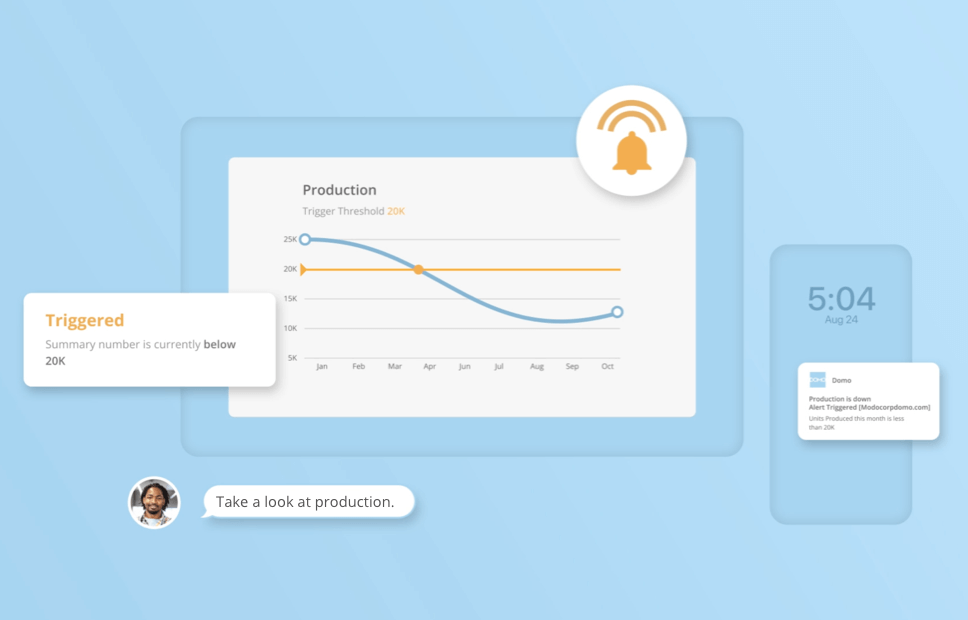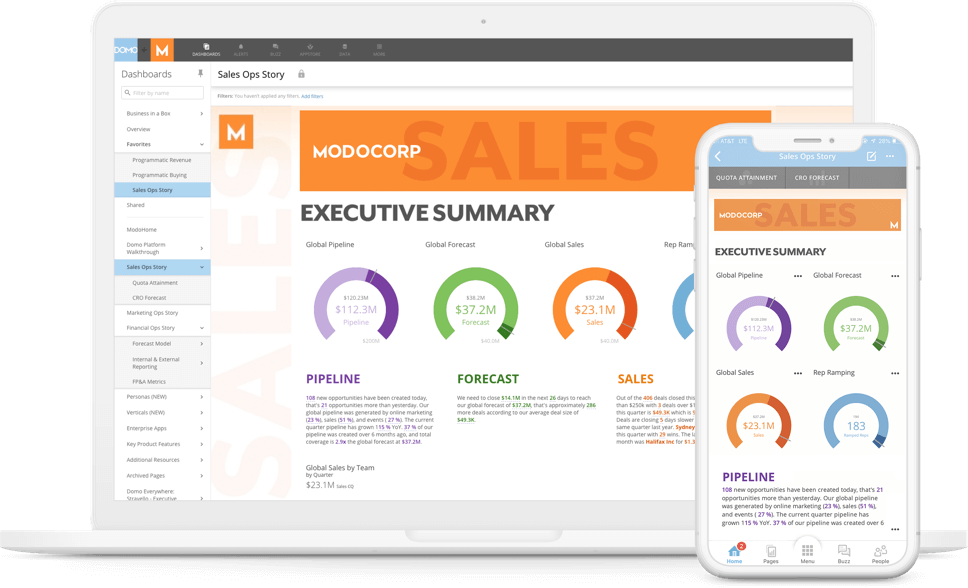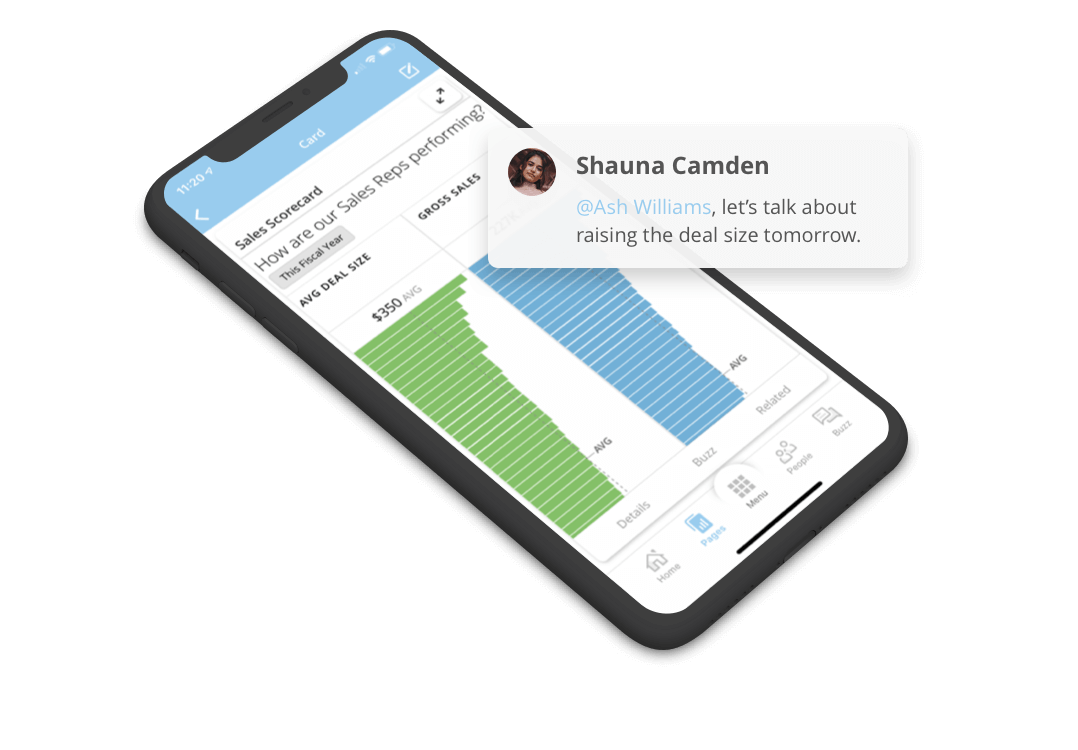What is cloud BI?
Cloud-based business intelligence, or cloud BI, describes the process of transforming data into actionable insights either partially or fully within a cloud environment. Cloud BI gives organizations the information they need to make data-driven decisions without the cost or hassle of physical hardware. All SaaS-form business intelligence is cloud BI.
Domo is a cloud BI solution and has been from the beginning.
Why is cloud BI important?
It’s difficult to find an organization today that doesn’t use at least one application that is based in the cloud — think customer relationship management (CRM) applications, online collaboration tools, internet file storage, and even some help desk software. It makes sense that organizations would want a cloud solution for their business intelligence as well.
The core of business intelligence is turning data into actionable insights. It’s all about getting the right insights to the right stakeholders at the right time. The cloud is the ideal addition to this process. It provides a fast, scalable way to process, store, deliver, and access data.
Benefits of cloud BI
To put the benefits of cloud BI into perspective, it’s important to understand the limitations of desktop BI tools. With desktop BI, IT loses visibility and governance when business users are pulling data items off of the cloud or server system to other devices which can create gaps in certification and make it difficult to track versions.
It’s also cumbersome to add disparate data sources into configured environments. This creates a BI ‘breadline’ where business users constantly need specific data to be utilized, but IT can’t fix ticket submissions quickly enough. The result is a backlog that prevents business decisions from being made in a timely manner.
Cloud BI solves these problems and provides a host of other benefits.
Easy to deploy
Since cloud BI solutions are internet-based, they are quick to install and simple enough that teams don’t need to wait on IT experts.
Intuitive design
Cloud BI tools typically come with dashboards that are easy to use so any stakeholder can navigate data insights and make smart decisions.
Automatic updates
Cloud BI solutions benefit from automatic software updates and implementation of new features. With no physical hardware to update, the latest and greatest options are immediately available to users.
Mobile access
With the rise of remote work, remote access is key. Cloud BI means that stakeholders are no longer limited to on-site access and desktop computers. Instead, their BI solutions, like Domo, can be accessed from anywhere on any device. Your custom dashboards are always at your fingertips.
Cost savings
With fewer on-site servers and IT staff needed to maintain and manage BI processes, cloud BI leads to reduced overhead costs.
Scalable resources
Cloud BI can scale up and down with an organization’s needs. It makes it simple to handle large volumes of data and add new users. It’s a more powerful way to compute, too.
Stay competitive
With traditional on-premise BI, the cost of service was prohibitive for many small- and medium-sized businesses. Cloud BI’s affordability means that companies of any size can access the benefits of better business intelligence.
Share securely
The innovations in cloud systems make it possible for organizations to ensure proper data governance and securely share insights with team members.
More accurate data
Cloud BI tools can process data rapidly and recheck data anytime. They offer precision that exceeds traditional BI tools and far exceeds manual data integration efforts.
How does cloud BI work?
To understand how cloud BI works, it’s important to have a solid understanding of the basic business intelligence process. Organizations create raw data every day. As part of data integration, extract, transform, load (ETL) tools collect, process, and store that data in either a data warehouse or a solution like Domo. Once the data is in a usable format and together in one place, stakeholders can begin to analyze it to find answers to their questions. Better business decisions from better data — that’s business intelligence.
Cloud BI moves this process from physical servers and hardware into a cloud environment. Generally, there are three cloud types:
Public cloud
A public cloud is an affordable cloud BI option because, in a public cloud, the cost of infrastructure is split among several cloud tenants.
Private cloud
A private cloud is a good option for organizations that have to be cognizant of data security and regulatory compliance. It is the most expensive of the three cloud options, but it offers dedicated storage and computing resources.
Hybrid cloud
Some organizations take a hybrid approach to the cloud. They may have certain data that is subject to strict regulations and other data that isn’t. A hybrid option allows them to store and analyze their most sensitive data in a private cloud and work with the rest of their data in a public cloud.
What should I look for in a cloud BI tool?
If you’re ready to move your business intelligence to the cloud, there are more options arriving on the market every day. Cloud BI software offers organizations many different capabilities, but those listed below are a few to look for.
Data management
Your cloud BI tool should have the capability to extract data from multiple sources, cleanse it for high-quality results, and transform it into a usable format. In business intelligence, the basics of data integration are crucial.
Advanced analytics
Advanced analytics capabilities like data mining and effective root-cause analysis are going to become more common needs across industries, so cloud BI tools should be prepared to deliver.
Reporting and visualization
Generating rich reports and clear, eye-catching visuals helps every user, no matter their analytics background, to understand the data insights they receive so they can put them to good use.
Collaboration
The more organizations can share relevant information across departments and teams, the more the entire business can benefit from data insights and move forward together with a unified goal in sight. Your cloud BI tool should allow you to easily share analytics.
How do different industries use cloud BI?
Cloud BI is useful in any industry, but some industries — like entertainment, healthcare, and finance — have adopted the tool more quickly than others. Across industries, cloud BI is being used to democratize data, save money, scale to meet demand, and deliver valuable insights in real time.
How will cloud BI evolve in the future?
Cloud BI is going to become more and more common. Its obvious benefits plus integration with other cloud applications will lead toward it becoming the default for modern organizations.
Instead of opening up a company-wide dashboard, stakeholders will be able to access a custom app built specifically for their department from anywhere in the world on any device. This approach will help streamline and automate workflows.
As an organization’s architecture grows more complex, cloud BI solutions will grow along with them to provide even more flexibility and essential capabilities.
RELATED RESOURCES

Report
Gartner Report | Predicts 2021: Analytics, BI and Data Science Solutions — Pervasive, Democratized and Composable

Report
Building A Data-Empowered Business Part 4: The Era of Cloud BI Is Here

Article




